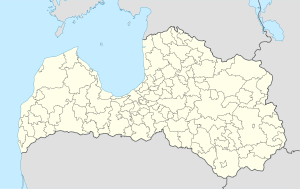- Alūksne
-
Alūksne — Town — The New Castle of Alūksne 
Flag
Coat of armsLocation in Latvia Coordinates: 57°25′N 27°3′E / 57.417°N 27.05°ECoordinates: 57°25′N 27°3′E / 57.417°N 27.05°E Country  Latvia
LatviaDistrict Alūksne municipality Town rights 1920 Government – Mayor Viktors Litaunieks Area – Total 14.2 km2 (5.5 sq mi) Elevation 217 m (712 ft) Population – Total 9,308 – Density 655/km2 (1,696.4/sq mi) Time zone EET (UTC+2) – Summer (DST) EEST (UTC+3) Postal code LV-430(1-2) Calling code +371 643 Alūksne (German:
 Marienburg (help·info)) is a town on the shores of Lake Alūksne in northeastern Latvia near the borders with Estonia and Russia. It is the seat of Alūksne municipality.
Marienburg (help·info)) is a town on the shores of Lake Alūksne in northeastern Latvia near the borders with Estonia and Russia. It is the seat of Alūksne municipality.History
The region around Lake Alūksne was originally settled by Finnic-speaking tribes, and from the 8th-12th centuries by Latgalians. The date of settlement at the current location of the town, then known as Olysta, Alyst, and Volyst, is given in the chronicles of Pskov as 1284. The later name Alūksne comes from the Latgalian word olūksna, meaning a spring in the forest.
The Latgalian inhabitants of the settlement were conquered by the German crusaders of the Livonian Order in 1342[citation needed] . They built a castle named Marienburg (after Mary, the mother of Jesus) on a nearby island, which served to protect trade routes from Riga to Pskov. The town which developed near the castle also became known as Marienburg.
Marienburg was captured by the troops of Ivan IV of Russia in 1560 during the Livonian War. It was incorporated into the Polish-Lithuanian Commonwealth in 1582. The town became part of the Swedish Empire in 1629.
Ernst Glück, a Lutheran clergyman and the first translator of the Bible into Latvian, founded the first Latvian language schools in Vidzeme in 1683. It is now the Alūksne Museum The Russian army led by Sheremetyev captured the town during the Great Northern War in 1702, doing great damage to the area and deporting all the inhabitants, including Glück and his foster daughter, Marta Skavronska, who later became Empress Catherine I of Russia.
The town's island is known as Pils Island (Castle Island) and Maria Island. Alūksne Castle is now used as an open air theater.
See also
Cities, Municipalities and Parishes of the defunct Alūksne District Cities Alūksne · Ape
Municipalities (none)
Parishes Towns with town rights in Latvia Ainaži · Aizkraukle · Aizpute · Aknīste · Aloja · Alūksne · Ape · Auce · Baldone · Baloži · Balvi · Bauska · Brocēni · Cēsis · Cesvaine · Dagda · Dobele · Durbe · Grobiņa · Gulbene · Ikšķile · Ilūkste · Jaunjelgava · Jēkabpils · Kandava · Kārsava · Krāslava · Kuldīga · Ķegums · Lielvārde · Līgatne · Limbaži · Līvāni · Lubāna · Ludza · Madona · Mazsalaca · Ogre · Olaine · Pāvilosta · Piltene · Pļaviņas · Preiļi · Priekule · Rūjiena · Sabile · Salacgrīva · Salaspils · Saldus · Saulkrasti · Seda · Sigulda · Skrunda · Smiltene · Staicele · Stende · Strenči · Subate · Talsi · Tukums · Valdemārpils · Valka · Valmiera · Vangaži · Varakļāni · Viesīte · Viļaka · Viļāni · ZilupeCategories:- Alūksne
- Towns in Latvia
- 1920 establishments in Latvia
- Castles of the Teutonic Knights
Wikimedia Foundation. 2010.


